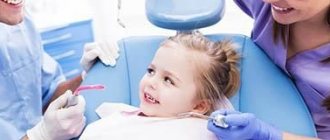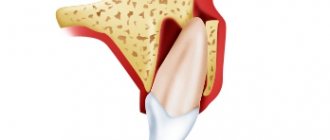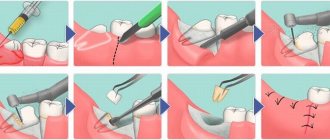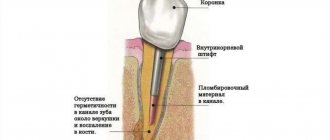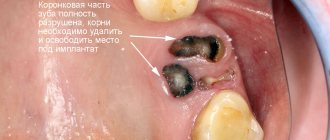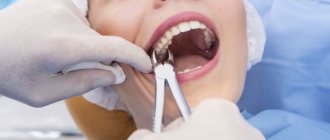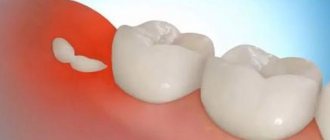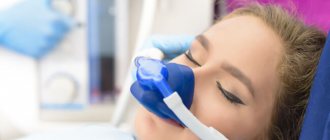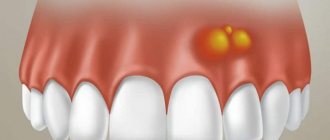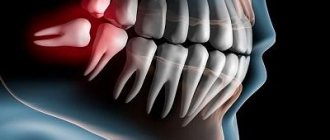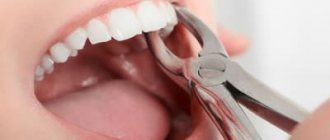Primary teeth are necessary so that, under the influence of occlusal load, a sufficient amount and volume of bone tissue is formed. Otherwise, permanent teeth simply would not be able to take root in the gums. Normally, a child's teeth are replaced in a certain order. As a result, the primary bite is replaced by a permanent one without pathologies.
Removal (extraction) of baby teeth only at first glance seems to be an absolutely simple procedure. If a baby tooth is lost long before a permanent tooth grows in its place, there is a risk of developing pathological changes in the bite. The decision to remove a child’s tooth must be made by a doctor.
Indications for tooth extraction in children
The absolute indications for the removal of baby teeth are:
- Neoplasms (cyst, phlegmon).
- Damage to the tooth with further development of a fistula.
- Severely advanced caries, as a result of which the crown of the tooth is completely destroyed.
- Chips and carious lesions in the crown of the tooth result in the formation of a sharp edge that injures the mucous membrane.
- Inflammation of the tissues adjacent to the tooth.
- The permanent tooth has already begun to erupt and the milk tooth interferes with it.
Let's understand the extent of damage to dental tissues
The proposed method of aesthetic restoration of a dental crown will depend on the degree of its damage.
- The appearance of a crack or chip in the enamel is considered minimal.
- They speak of average when not only the enamel breaks off, but also the dentin located underneath it.
- If the pulp chamber is opened and the nerve is exposed, we are talking about severe damage. It is clear that in this case, before dental prosthetics in Moscow, the pulp will have to be removed and the canals treated.
the tooth wall to break off during an injury , there must also be a certain internal reason. Such troubles occur much more often in people with low acidity in the mouth, with an incorrect bite, with teeth crowded and rotated around their axis, and with hormonal imbalance. Bad habits can also be the cause: from smoking and alcohol abuse to excessive indulgence in sweets and carbohydrate foods.
Contraindications
It is not recommended to remove a child’s baby teeth in the following cases:
- Severe chronic conditions (heart defects, epilepsy, etc.).
- Inflammation in the oral cavity (stomatitis, gingivitis).
- Problems with blood clotting.
- Infectious diseases in the acute phase (ARVI, influenza, scarlet fever, chickenpox, etc.).
If there are contraindications, tooth extraction can be dangerous. But not all contraindications are absolute. For example, if the baby has an inflammatory process or an infectious disease, the tooth can be removed after treatment. The final decision about the procedure will be made by the dentist.
Why do baby teeth fall out and in what cases are they removed?
Milk units, like permanent ones, have roots. However, they are short and can dissolve on their own. The natural loss of time units occurs precisely for this reason. At the same time, the tooth begins to loosen and falls out. This process usually does not cause discomfort to children.
However, sometimes babies lose teeth due to injury. With a strong impact, the tooth element is damaged and falls off. If by this time the root has not dissolved, then it remains in the hole. Removing temporary teeth is highly undesirable, since it entails a change in the bite. A tooth is pulled out if the following indications are present:
- due to the injury, a sharp fragment remains, which causes discomfort;
- caries has led to the destruction of most of the milk unit;
- caries spreads deeper, there is a danger of damage to the rudiments of permanent teeth;
- diagnosed with pulpitis;
- a tumor was discovered on the gum;
- a loose tooth causes discomfort to the child;
- a temporary unit prevents the growth of a constant one.
Removal without pain
In pediatric dentistry, it is very important to ensure the child’s comfort during the tooth extraction procedure. This applies to all stages of treatment. To prevent the baby from being afraid, double anesthesia is used:
- Anesthetic gel. It is necessary to reduce the sensitivity of the gums and prepare for further anesthesia.
- Injection anesthesia. After the gel begins to take effect, the nurse will inject an anesthetic into the gum. Thanks to the action of the gel, the child does not feel pain from the injection.
Many drugs for local anesthesia, which are used to anesthetize tooth extraction, are strong allergens. In order to exclude the possibility of an allergy, the child is given a skin test.
What if there is a root left in the gum?
In this case, most dentists do not recommend resorting to extraction of the remaining process. You need to wait until it resolves on its own. You should contact your dentist in the following situations:
- the remaining piece interferes with the child;
- the prolapsed unit is severely affected by caries;
- after the loss, the inflammatory process began.
Some sources contain information that if the remaining spine is loose, you can remove it yourself. However, experts do not recommend resorting to removal at home, since there is a risk of damage to nearby units and infection of the wound.
You should contact your dentist, who will take a photo to determine your next course of action. If the remaining process is dangerous for the permanent unit or causes discomfort to the child, it will be removed.
Features of milk teeth removal
Milk teeth have their own characteristics:
- Thin alveolar walls.
- Weak, poorly defined neck.
- Divergence of roots in different directions.
To remove teeth, forceps with a slight fixation are used. The doctor grabs the crown with forceps, turns the tooth inside out and removes it from the socket. After this, the hole must be carefully inspected. Due to the structural features of baby teeth, there is a risk that part of the root or crown will remain in the socket. If everything is normal and there are no fragments in the hole, a sterile swab will be placed on the child’s wound. This helps stop bleeding faster and protects the wound.
The extraction procedure is quick. Thanks to double anesthesia, the baby does not feel pain at all. Removal is comfortable, without pain and fear.
Possible reasons why a child’s baby tooth has fallen out
The main reason for the loss of baby teeth is the eruption of permanent teeth. The process of replacing baby teeth is preceded by the resorption of their roots. After root loss, the baby tooth becomes loose and falls out. Most often, the process does not cause the child significant discomfort or pain, and the vacated space is subsequently filled with the erupting permanent incisor.
Replacing a baby tooth with a permanent one
Attention! The replacement of baby teeth with permanent ones is a natural process established by nature. Root teeth are stronger and more resilient, they are distinguished by the hardness and density of the enamel, therefore making it easier for the child to adapt to adult food.
The first loss of baby teeth occurs after the child reaches the age of six, which is considered the norm in dentistry. It takes 6 to 8 years for permanent teeth to form.
Care after removal
In order for the wound to heal normally, you need to follow the recommendations for caring for your teeth after extraction. An infection can easily penetrate through an unhealed wound, which means that without care there is a risk of developing inflammation.
Caring for your child’s oral cavity is very simple:
- Immediately after removal, it is important to prevent the blood clot from being washed out of the socket. Therefore, the child should not eat or drink anything.
- The wound should be protected as much as possible from the risk of infection. You can't touch it with your hands. You need to make sure that the baby does not touch the hole. Penetration of infection can lead to the development of inflammation, suppuration and other complications.
- The first three days you need to do mouth baths. You can use medications that your surgeon recommends. Suitable decoctions of herbs with antiseptic and anti-inflammatory properties - sage, chamomile.
- The child’s diet should be monitored for the first five days. You should not eat solid food, cold and hot drinks, or confectionery.
If you follow these simple rules, a child almost never experiences complications after the removal of a baby tooth. In case of infection, you should immediately show the child to a doctor. You should come for examination if the following symptoms appear:
- Continuous bleeding. After removal of a dental unit, the wound may bleed for several hours. If the bleeding does not stop, you should consult a doctor.
- Bad breath. It may be a sign of developing inflammation or suppuration. The inflammatory process quickly spreads to other tissues, which can cause serious complications.
- Fever. Speaks of infection or inflammatory process. Immediately after surgery, your temperature may rise slightly. This is often due to the stress that the child experiences in the dental chair. If the temperature persists for a long time or rises during the healing process, you cannot delay a visit to the dental clinic.
What to do if the root of a baby tooth remains in the gum?
A situation where a child’s baby tooth falls out, but the root remains, can drive all parents into hysterics. In fact, in most cases, the fears of mothers and fathers are not confirmed, and the visible particle in the resulting wound turns out to be only the tip of an erupting permanent tooth.
However, particles of primary incisors also often remain in the gums , which is explained by the fragility of temporary bone formations. But it must be taken into account that such situations only happen when a baby tooth is removed prematurely, the roots of which have not yet had time to dissolve, or as a result of injury.
Important! If the first baby tooth has fallen out, which by that time was already loose, there is no reason to worry, because the remaining fragment is an erupting root tooth. Otherwise, and to reassure parents, it is better to contact a pediatric dentist, who will prescribe an X-ray examination and be able to determine the nature of the visible bone structure.
On the Internet you can find many recommendations regarding the situation when the root of a baby tooth remains in the gum. If the destruction of a baby tooth occurs due to injury and the remaining part is the root system, you can carefully take the fragment and check whether it is loose.
Baby tooth fell out without root
It is not difficult to remove a loose root of a baby tooth, but it is important to ensure that the procedure is sterile. If the root sits firmly in the gum, you need to exclude any third-party influence on it, including eating solid food, and immediately visit a pediatric dentist.
How does removing baby teeth affect your bite?
Removing baby teeth can be dangerous for the bite if the permanent teeth have not yet begun to emerge. The prolonged absence of a dental unit leads to the fact that neighboring ones begin to move, filling the empty space. When permanent teeth begin to emerge, they run out of space. This leads to the development of various bite defects.
When removal cannot be avoided, it is recommended to install special artificial crowns. This way you can avoid tooth movement and changes in your bite.
In addition to the risk of developing malocclusion, early removal of baby teeth may have other consequences:
- Articulation impairment. Because of this, speech defects often form, which can become a barrier to communication with others. Communication with peers is very important for a child. Problems due to speech defects can be a harbinger of psychological disorders.
- Digestive problems. Due to the lack of teeth, chewing becomes difficult and the process of processing food in the oral cavity is disrupted. Chewing is an important step in the digestion process. Its violation can lead to the development of gastrointestinal diseases.
You cannot remove baby teeth yourself, even if they are mobile. Extraction is a surgical procedure. An experienced specialist should remove teeth.
The Zuub.rf clinic has a children's department. Pediatric dentists and surgeons work here. The operation will be comfortable and completely safe for your baby.
What does a lost baby tooth look like (photos below)?
Many parents, out of ignorance, tend to think that baby teeth do not have roots at all. At the same time, some mothers and fathers are horrified when a developed root system is not found on a lost baby tooth, believing that part of the tooth remains in the child’s gum. Brief information about what a lost baby tooth looks like will help dispel all the myths. A photo of the removed bone formation will provide the best idea of it.
Temporary incisors are identical to permanent incisors in structure, but differ in smaller crown sizes, thinner enamel and the presence of rather wide canals and large pulp. Despite numerous misconceptions, the root system of a baby tooth is present and ensures the proper performance of the functions of grinding food and forming a normal bite.
Pulled out milk tooth with root
The absence of roots in a fallen baby tooth is explained by their resorption at a certain stage of a person’s life to allow permanent bone structures to erupt, which is the norm.
What to do with the roots of decayed baby teeth? Should they be removed? Or will they fall out on their own?
My son is 3 years old. I have had dental problems since I was one and a half years old. It all started when the front teeth began to rot and decay. We went to the dentist. They offered nothing more than silver plating. We refused because... many say that after this procedure the teeth become black and still rot. As a result, by the age of 3, our 4 front teeth had completely rotted, leaving only brown roots in the gums. What to do with them? Should they be removed? Or will they fall out on their own? If removed, when (now or when the main teeth come in)?
Your mail:What to do after the procedure?
After the process is pulled out, a small bleeding wound is formed. To speed up the healing process and eliminate the risk of infection, you must do the following:
- place a clean cotton swab in the formed hole for 15–20 minutes;
- do not give the child food or drinks for 3 hours;
- for several days, avoid eating hot and cold foods, visiting the sauna and taking a hot bath;
- until the wound is completely healed, perform oral hygiene carefully using a soft brush;
- Do not warm the damaged area with compresses.
